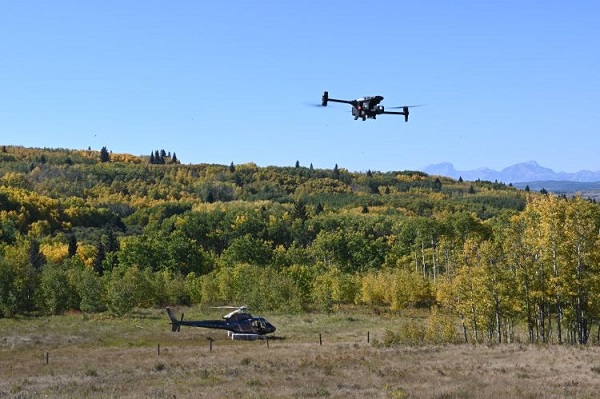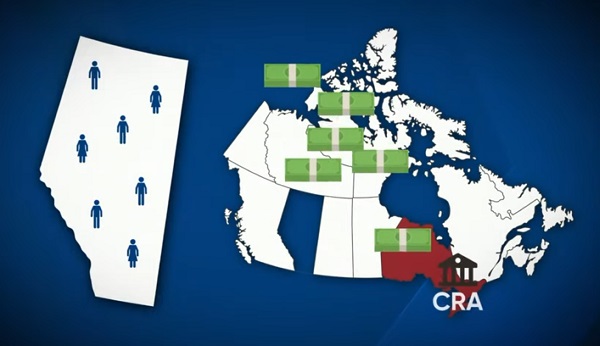Alberta
Taking wildfire operations to new heights

Drone and helicopter testing being performed by Alberta Wildfire personnel. Photo Credit: Alberta Wildfire
Budget 2024 enables Alberta to make use of leading-edge technologies to prevent and respond to wildfires.
As Alberta heads into wildfire season, many areas of the province are experiencing heightened wildfire risk. Alberta’s government continues to prioritize new technologies and tactics that will enhance front-line response and suppression efforts.
Budget 2024 will invest an additional $151 million over the next three years for wildfire preparedness, prevention, response and mitigation. This additional funding will enhance wildland firefighting capacity with increased wildfire resources such as personnel, aircraft, drones, artificial intelligence (AI) and night-vision technology.
“Alberta’s government is well prepared for the 2024 wildfire season. We have emerging technologies that will enable us to better protect forests and communities while continuing to prioritize proactive measures that build wildfire resilience throughout the province.”
Aerial operations are integral to firefighting efforts and increased funding will enable the province to add two additional long-term helicopter contracts, two new air tanker contracts and additional drones for aerial wildfire surveillance. Budget 2024 will also support the renewal of 130 helicopter contracts by April 1.
“We live in a time where we have access to incredible technologies and last year, we recognized some great successes from various firefighting technology pilot programs. I can say with confidence that the additional night-vision equipped helicopters and drones will make a big difference in our wildfire mitigation and response efforts this year.”
Alberta Wildfire will continue to explore, research and test new developments in wildfire prevention, mitigation, smoke detection and suppression to assess how innovative technologies can support a rapid response and help extinguish wildfires. Wildfire management best practices are always evolving, and Alberta’s government is working to stay ahead of the curve.
For future wildfire seasons, the government is exploring options to potentially expand the province’s air tanker fleet and pilot more emerging firefighting technologies.
Quick facts
- Night-vision goggles amplify light 60,000 times and allow helicopter pilots to work overnight and conduct activities like bucketing operations.
- Wildfire suppression efforts are more likely to be successful at night, as temperatures are usually lower, humidity is typically higher and wildfires are less active.
- Alberta has been successfully using an AI wildfire occurrence prediction system since 2022 to identify areas where wildfires are likely to occur.
- Budget 2024 also includes hiring 100 new firefighters, which will result in five additional 20-person crews.
Alberta
Alberta Next: Taxation

A new video from the Alberta Next panel looks at whether Alberta should stop relying on Ottawa to collect our provincial income taxes. Quebec already does it, and Alberta already collects corporate taxes directly. Doing the same for personal income taxes could mean better tax policy, thousands of new jobs, and less federal interference. But it would take time, cost money, and require building new systems from the ground up.
Alberta
Cross-Canada NGL corridor will stretch from B.C. to Ontario

Keyera Corp.’s natural gas liquids facilities in Fort Saskatchewan. Photo courtesy Keyera Corp.
From the Canadian Energy Centre
By Will Gibson
Keyera ‘Canadianizes’ natural gas liquids with $5.15 billion acquisition
Sarnia, Ont., which sits on the southern tip of Lake Huron and peers across the St. Clair River to Michigan, is a crucial energy hub for much of the eastern half of Canada and parts of the United States.
With more than 60 industrial facilities including refineries and chemical plants that produce everything from petroleum, resins, synthetic rubber, plastics, lubricants, paint, cosmetics and food additives in the southwestern Ontario city, Mayor Mike Bradley admits the ongoing dialogue about tariffs with Canada’s southern neighbour hits close to home.
So Bradley welcomed the announcement that Calgary-based Keyera Corp. will acquire the majority of Plains American Pipelines LLP’s Canadian natural gas liquids (NGL) business, creating a cross-Canada NGL corridor that includes a storage hub in Sarnia.
“As a border city, we’ve been on the frontline of the tariff wars, so we support anything that helps enhance Canadian sovereignty and jobs,” says the long-time mayor, who was first elected in 1988.
The assets in Sarnia are a key piece of the $5.15 billion transaction, which will connect natural gas liquids from the growing Montney and Duvernay plays in B.C. and Alberta to markets in central Canada and the eastern U.S. seaboard.
NGLs are hydrocarbons found within natural gas streams including ethane, propane and pentanes. They are important energy sources and used to produce a wide range of everyday items, from plastics and clothing to fuels.
Keyera CEO Dean Setoguchi cast the proposed acquisition as an act of repatriation.
“This transaction brings key NGL infrastructure under Canadian ownership, enhancing domestic energy capabilities and reinforcing Canada’s economic resilience by keeping value and decision-making closer to home,” Setoguchi told analysts in a June 17 call.
“Plains’ portfolio forms a fully integrated cross Canada NGL system connecting Western Canada supply to key demand centres across the Prairie provinces, Ontario and eastern U.S.,” he said.
“The system includes strategic hubs like Empress, Fort Saskatchewan and Sarnia – which provide a reliable source of Canadian NGL supply to extensive fractionation, storage, pipeline and logistics infrastructure.”
Martin King, RBN Energy’s managing director of North America Energy Market Analysis, sees Keyera’s ability to “Canadianize” its NGL infrastructure as improving the company’s growth prospects.
“It allows them to tap into the Duvernay and Montney, which are the fastest growing NGL plays in North America and gives them some key assets throughout the country,” said the Calgary-based analyst.
“The crown assets are probably the straddle plants in Empress, which help strip out the butane, ethane and other liquids for condensate. It also positions them well to serve the eastern half of the country.”
And that’s something welcomed in Sarnia.
“Having a Canadian source for natural gas would be our preference so we see Keyera’s acquisition as strengthening our region as an energy hub,” Bradley said.
“We are optimistic this will be good for our region in the long run.”
The acquisition is expected to close in the first quarter of 2026, pending regulatory approvals.
Meanwhile, the governments of Ontario and Alberta are joining forces to strengthen the economies of both regions, and the country, by advancing major infrastructure projects including pipelines, ports and rail.
A joint feasibility study is expected this year on how to move major private sector-led investments forward.
-

 Uncategorized13 hours ago
Uncategorized13 hours agoCNN’s Shock Climate Polling Data Reinforces Trump’s Energy Agenda
-

 Business2 days ago
Business2 days ago103 Conflicts and Counting Unprecedented Ethics Web of Prime Minister Mark Carney
-

 illegal immigration1 day ago
illegal immigration1 day agoICE raids California pot farm, uncovers illegal aliens and child labor
-

 Frontier Centre for Public Policy13 hours ago
Frontier Centre for Public Policy13 hours agoCanada’s New Border Bill Spies On You, Not The Bad Guys
-

 Opinion5 hours ago
Opinion5 hours agoPreston Manning: Three Wise Men from the East, Again
-

 Addictions5 hours ago
Addictions5 hours agoWhy B.C.’s new witnessed dosing guidelines are built to fail
-

 Business3 hours ago
Business3 hours agoCarney Liberals quietly award Pfizer, Moderna nearly $400 million for new COVID shot contracts
-

 Energy1 day ago
Energy1 day agoLNG Export Marks Beginning Of Canadian Energy Independence







